2020年考博英语阅读解题技巧:例证题
考博英语阅读十大解题思路
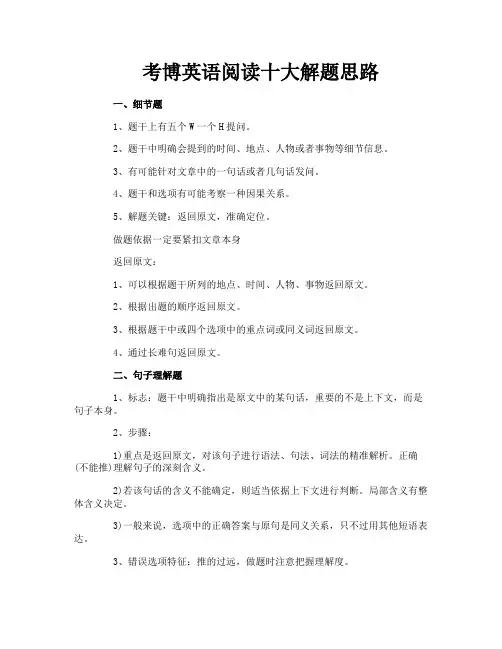
考博英语阅读十大解题思路一、细节题1、题干上有五个W一个H提问。
2、题干中明确会提到的时间、地点、人物或者事物等细节信息。
3、有可能针对文章中的一句话或者几句话发问。
4、题干和选项有可能考察一种因果关系。
5、解题关键:返回原文,准确定位。
做题依据一定要紧扣文章本身返回原文:1、可以根据题干所列的地点、时间、人物、事物返回原文。
2、根据出题的顺序返回原文。
3、根据题干中或四个选项中的重点词或同义词返回原文。
4、通过长难句返回原文。
二、句子理解题1、标志:题干中明确指出是原文中的某句话,重要的不是上下文,而是句子本身。
2、步骤:1)重点是返回原文,对该句子进行语法、句法、词法的精准解析。
正确(不能推)理解句子的深刻含义。
2)若该句话的含义不能确定,则适当依据上下文进行判断。
局部含义有整体含义决定。
3)一般来说,选项中的正确答案与原句是同义关系,只不过用其他短语表达。
3、错误选项特征:推的过远,做题时注意把握理解度。
4、正确选项不包含过于绝对化的词语。
三、主旨大意题1、标志:best title, main idea, main problem,conclusion,mainly disguss, mainly deal with或者问作者的写作目的purpose, the author intends to do sth, a digest of利用宏观阅读技巧作主旨题,不管是出现在什么位置,都把他作为最后一题来做。
2、方法:1)段落少,用串线法。
2)快速作文法:两个选项难以分辨的时候,用这两个选项做作文,快速给出提纲。
3、选项不能选择局部信息,也不能选范围过宽的信息。
四、态度题1、标志:题干中出现attitude ,believe ,consider, deam,regard,deem2、作者态度可以分为三大类:1)正态度:支持,乐观,赞同2)客观、中立、公正3)反对、批评、怀疑3、等价选项都不选4、有些选项一定不是正确答案(永陪选项):indifferent(漠不关心);subjective(主观的);biased(有偏见的);puzzled(迷惑不解的)5、识别作者态度:方法一:可以根据作者论述的主线及举例的方式进行判断。
2020年考研英语阅读:例证题常见四种题型特点
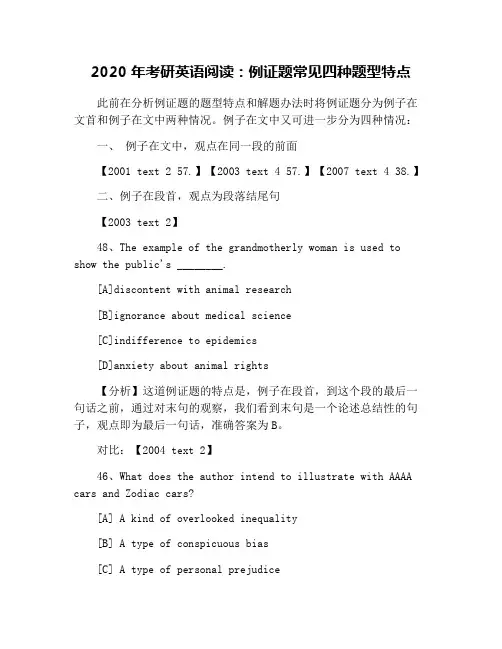
2020年考研英语阅读:例证题常见四种题型特点此前在分析例证题的题型特点和解题办法时将例证题分为例子在文首和例子在文中两种情况。
例子在文中又可进一步分为四种情况:一、例子在文中,观点在同一段的前面【2001 text 2 57.】【2003 text 4 57.】【2007 text 4 38.】二、例子在段首,观点为段落结尾句【2003 text 2】48、The example of the grandmotherly woman is used to show the public's ________.[A]discontent with animal research[B]ignorance about medical science[C]indifference to epidemics[D]anxiety about animal rights【分析】这道例证题的特点是,例子在段首,到这个段的最后一句话之前,通过对末句的观察,我们看到末句是一个论述总结性的句子,观点即为最后一句话,准确答案为B。
对比:【2004 text 2】46、What does the author intend to illustrate with AAAA cars and Zodiac cars?[A] A kind of overlooked inequality[B] A type of conspicuous bias[C] A type of personal prejudice[D] A kind of brand discrimination【分析】这道题和上一个例子从形式上看如出一辙,但是仔细观察发现例子后的句子同样是在讲例子、摆事实,不是总结论述的话,所以这道题的观点只能往前面找,就找到了一段中的中心句或最后一句,都能够得出答案,准确答案为A。
三、例子独立一段,观点在前面二阶真题阅读中没有,这种情况比如在2002 text 1这篇文章中二段整段都为例子,其论证的观点就在一段。
医学考博英语阅读理解整体解题思路
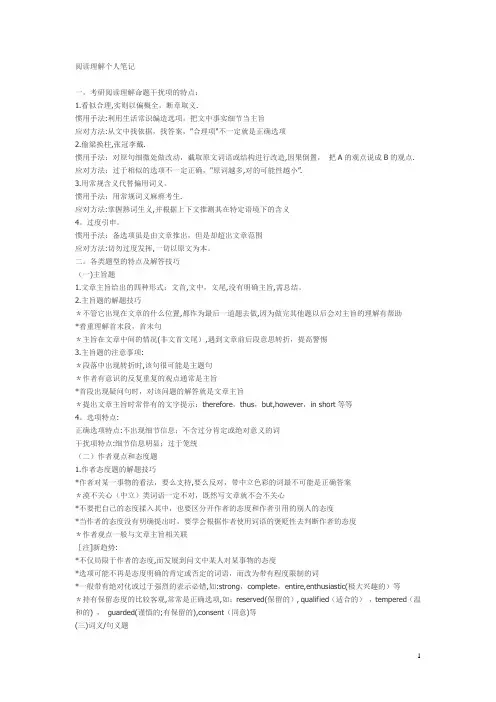
阅读理解个人笔记一。
考研阅读理解命题干扰项的特点:1.看似合理,实则以偏概全,断章取义.惯用手法:利用生活常识编造选项,把文中事实细节当主旨应对方法:从文中找依据,找答案,"合理项"不一定就是正确选项2.偷梁换柱,张冠李戴.惯用手法:对原句细微处做改动,截取原文词语或结构进行改造,因果倒置,把A的观点说成B的观点. 应对方法:过于相似的选项不一定正确,"原词越多,对的可能性越小”.3.用常规含义代替偏用词义。
惯用手法:用常规词义麻痹考生.应对方法:掌握熟词生义,并根据上下文推测其在特定语境下的含义4。
过度引申。
惯用手法:备选项虽是由文章推出,但是却超出文章范围应对方法:切勿过度发挥,一切以原文为本。
二。
各类题型的特点及解答技巧(一)主旨题1.文章主旨给出的四种形式:文首,文中,文尾,没有明确主旨,需总结。
2.主旨题的解题技巧*不管它出现在文章的什么位置,都作为最后一道题去做,因为做完其他题以后会对主旨的理解有帮助*着重理解首末段,首末句*主旨在文章中间的情况(非文首文尾),遇到文章前后段意思转折,提高警惕3.主旨题的注意事项:*段落中出现转折时,该句很可能是主题句*作者有意识的反复重复的观点通常是主旨*首段出现疑问句时,对该问题的解答就是文章主旨*提出文章主旨时常伴有的文字提示:therefore,thus,but,however,in short等等4。
选项特点:正确选项特点:不出现细节信息;不含过分肯定或绝对意义的词干扰项特点:细节信息明显;过于笼统(二)作者观点和态度题1.作者态度题的解题技巧*作者对某一事物的看法,要么支持,要么反对,带中立色彩的词最不可能是正确答案*漠不关心(中立)类词语一定不对,既然写文章就不会不关心*不要把自己的态度揉入其中,也要区分开作者的态度和作者引用的别人的态度*当作者的态度没有明确提出时,要学会根据作者使用词语的褒贬性去判断作者的态度*作者观点一般与文章主旨相关联[注]新趋势:*不仅局限于作者的态度,而发展到问文中某人对某事物的态度*选项可能不再是态度明确的肯定或否定的词语,而改为带有程度限制的词*一般带有绝对化或过于强烈的表示必错,如:strong,complete,entire,enthusiastic(极大兴趣的)等*持有保留态度的比较客观,常常是正确选项,如:reserved(保留的), qualified(适合的),tempered(温和的) ,guarded(谨慎的;有保留的),consent(同意)等(三)词义/句义题1.对词义考察的两种方式:超纲词义含义推断;熟词生义或是在特定场合的意思2.词义题的解题技巧:*根据上下文进行推理猜测,两个原则<1>不管这个词多超纲,根据上下文都能得出其意思<2〉不管这个词多熟悉,都要通过上下文得出其在特定场合的意思*正确选项不是熟词的常规含义3.猜测词义的方法:*构词法:根据词根,词缀判断词义*词性加搭配:先判断生词在文章中的词性,再看它与哪些词语可以搭配,最后根据自己的常识推测*找同义词,同义解释,反义词,反义解释:在上下文中找出生词的其他表示方法,由此推断其含义*找同位词:上下文中有可能有类似生词出现的句子的平行结构,找出其中和生词处于同一位置的词去推测4。
中科院考博英语高分技巧-3
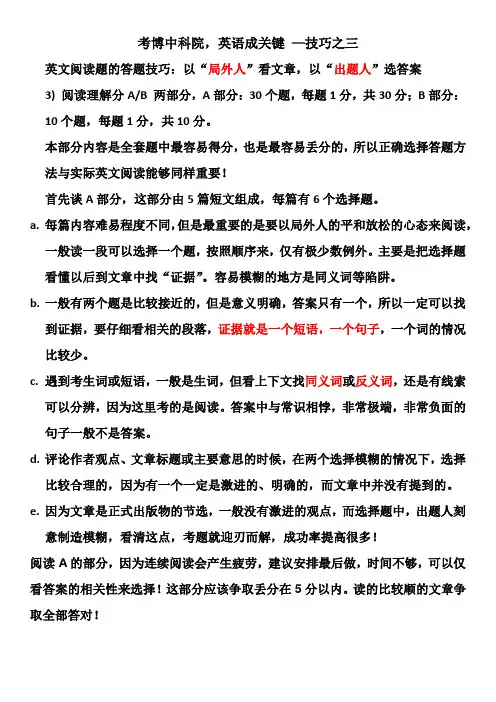
考博中科院,英语成关键—技巧之三英文阅读题的答题技巧:以“局外人”看文章,以“出题人”选答案3) 阅读理解分A/B 两部分,A部分:30个题,每题1分,共30分;B部分:10个题,每题1分,共10分。
本部分内容是全套题中最容易得分,也是最容易丢分的,所以正确选择答题方法与实际英文阅读能够同样重要!首先谈A部分,这部分由5篇短文组成,每篇有6个选择题。
a.每篇内容难易程度不同,但是最重要的是要以局外人的平和放松的心态来阅读,一般读一段可以选择一个题,按照顺序来,仅有极少数例外。
主要是把选择题看懂以后到文章中找“证据”。
容易模糊的地方是同义词等陷阱。
b.一般有两个题是比较接近的,但是意义明确,答案只有一个,所以一定可以找到证据,要仔细看相关的段落,证据就是一个短语,一个句子,一个词的情况比较少。
c.遇到考生词或短语,一般是生词,但看上下文找同义词或反义词,还是有线索可以分辨,因为这里考的是阅读。
答案中与常识相悖,非常极端,非常负面的句子一般不是答案。
d.评论作者观点、文章标题或主要意思的时候,在两个选择模糊的情况下,选择比较合理的,因为有一个一定是激进的、明确的,而文章中并没有提到的。
e.因为文章是正式出版物的节选,一般没有激进的观点,而选择题中,出题人刻意制造模糊,看清这点,考题就迎刃而解,成功率提高很多!阅读A的部分,因为连续阅读会产生疲劳,建议安排最后做,时间不够,可以仅看答案的相关性来选择!这部分应该争取丢分在5分以内。
读的比较顺的文章争取全部答对!再谈B部分,这部分由2篇短文组成,每篇有5个填空选择题。
这部分是一个长句子来填空,答案中有一个无关的答案,用来干扰考生的理解能力。
这部分内容,初看比较难,但是实际上也有技巧。
a.每篇内容难易程度不同,但是第一个填空一般比较重要,而最后一个填空比较容易,文章中也会出现一个填空比较容易“定位”。
其次是与填空无关的假句子也比较容易发现。
b.一旦发现比较明确的填空马上定位,通过上下文的逻辑衔接,内容连续性,事情的叙述通顺性,合理性就可以找到另外一个答案,在定位答案的前后,如果有了两个比较明确的答案,其他的填空就比较明显了,所以时间要花在第一个定位和明显的定位上。
考博英语阅读理解试题分类解析-考试要求、命题形式与解题技巧【圣才出品】
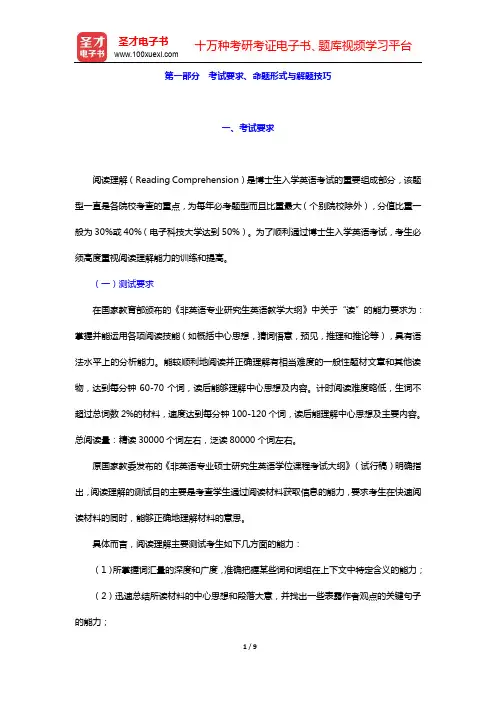
第一部分考试要求、命题形式与解题技巧一、考试要求阅读理解(Reading Comprehension)是博士生入学英语考试的重要组成部分,该题型一直是各院校考查的重点,为每年必考题型而且比重最大(个别院校除外),分值比重一般为30%或40%(电子科技大学达到50%)。
为了顺利通过博士生入学英语考试,考生必须高度重视阅读理解能力的训练和提高。
(一)测试要求在国家教育部颁布的《非英语专业研究生英语教学大纲》中关于“读”的能力要求为:掌握并能运用各项阅读技能(如概括中心思想,猜词悟意,预见,推理和推论等),具有语法水平上的分析能力。
能较顺利地阅读并正确理解有相当难度的一般性题材文章和其他读物,达到每分钟60-70个词,读后能够理解中心思想及内容。
计时阅读难度略低,生词不超过总词数2%的材料,速度达到每分钟100-120个词,读后能理解中心思想及主要内容。
总阅读量:精读30000个词左右,泛读80000个词左右。
原国家教委发布的《非英语专业硕士研究生英语学位课程考试大纲》(试行稿)明确指出,阅读理解的测试目的主要是考查学生通过阅读材料获取信息的能力,要求考生在快速阅读材料的同时,能够正确地理解材料的意思。
具体而言,阅读理解主要测试考生如下几方面的能力:(1)所掌握词汇量的深度和广度,准确把握某些词和词组在上下文中特定含义的能力;(2)迅速总结所读材料的中心思想和段落大意,并找出一些表露作者观点的关键句子的能力;(3)对所读材料各段落之间的逻辑意义进行判断、推理和引申的能力;(4)注意一些对理解全文或某个关键句子起着重要的作用的细节问题的能力;(5)领会作者的观点和判断作者的态度,或者从阅读材料所隐含的意思中推断出作者的观点和态度的能力。
总之,阅读理解部分不但要求掌握所读材料的主旨大意、中心思想,而且要求考生注意文中细节;不但要求对具体事实情节的理解,而且要求对其抽象含义的理解,既要理解字面意思,又要理解其深层含义,包括作者的态度、观点、意图等;既要求理解文中某句、某段的含义及全文的逻辑关系,又要求根据其含义及逻辑关系进行判断和推理;既要求考生能够运用材料中的信息去理解、分析问题,又要求考生能运用应有的常识去分析、理解问题。
英语例证题阅读技巧
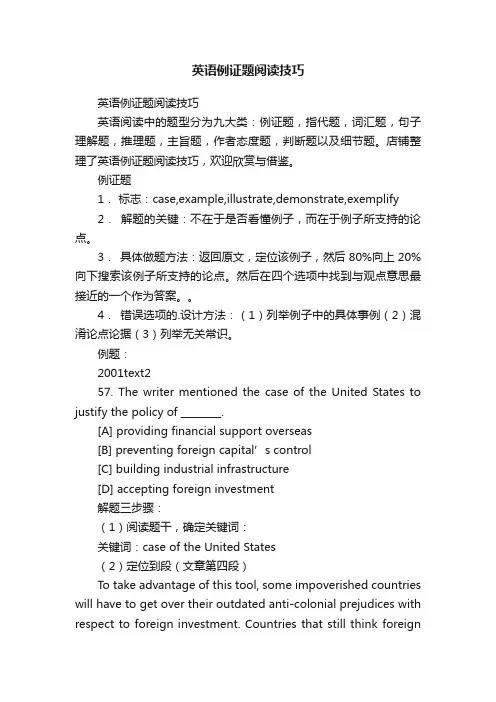
英语例证题阅读技巧英语例证题阅读技巧英语阅读中的题型分为九大类:例证题,指代题,词汇题,句子理解题,推理题,主旨题,作者态度题,判断题以及细节题。
店铺整理了英语例证题阅读技巧,欢迎欣赏与借鉴。
例证题1.标志:case,example,illustrate,demonstrate,exemplify2.解题的关键:不在于是否看懂例子,而在于例子所支持的论点。
3.具体做题方法:返回原文,定位该例子,然后80%向上20%向下搜索该例子所支持的论点。
然后在四个选项中找到与观点意思最接近的一个作为答案。
4.错误选项的.设计方法:(1)列举例子中的具体事例(2)混淆论点论据(3)列举无关常识。
例题:2001text257. The writer mentioned the case of the United States to justify the policy of ________.[A] providing financial support overseas[B] preventing foreign capital’s control[C] building industrial infrastructure[D] accepting foreign investment解题三步骤:(1)阅读题干,确定关键词:关键词:case of the United States(2)定位到段(文章第四段)To take advantage of this tool, some impoverished countries will have to get over their outdated anti-colonial prejudices with respect to foreign investment. Countries that still think foreigninvestment is an invasion of their sovereignty might well study the history of infrastructure (the basic structural foundations of a society) in the United States. When the United States built its industrial infrastructure, it didn’t have the capital to do so. And that is why America’s Second Wave infrastructure -- including roads, harbors, highways, ports and so on -- were built with foreign investment. The English, the Germans, the Dutch and the French were investing in Britain’s former colony. They financed them. Immigrant Americans built them. Guess who owns them now? The Americans. I believe the same thing would be true in places like Brazil or anywhere else for that matter. The more foreign capital you have helping you build your Third Wave infrastructure, which today is an electronic infrastructure, the better off you’re going to be. That doesn’t me an lying down and becoming fooled, or letting foreign corporations run uncontrolled. But it does mean recognizing how important they can be in building the energy and telecom infrastructures needed to take full advantage of the Internet.(3)定位到句,同义替换,得出答案。
博士英语阅读理解解题技巧
博士英语阅读理解解题技巧Title: Mastering English Reading Comprehension for Doctoral Students.English reading comprehension is a crucial skill for doctoral students, especially in an academic environment where a deep understanding of research articles, theses, and dissertations is essential. Mastering this skill requires a combination of strategic approaches and regular practice. Here are some tips to help doctoral students excel in English reading comprehension.1. Understand the Purpose of Reading.Before delving into any text, it's important to understand why you are reading it. Are you looking for specific information? Trying to understand a new concept? Or, are you analyzing an argument? Knowing your purpose helps you focus on the relevant information and saves time.2. Preview the Text.Scanning the title, subtitles, and conclusions before reading the entire text gives you an overview of the content. This previewing helps you anticipate what the text is about and prepare your mind for the information.3. Active Reading.Passive reading, where you simply scan the words, is not effective for comprehension. Active reading involves actively engaging with the text. This includes highlighting key ideas, taking notes, and asking yourself questions about the content.4. Expand Your Vocabulary.A rich vocabulary enhances your reading comprehension. Encountering unfamiliar words? Don't immediately skip them. Instead, try to guess their meaning based on the context. Look them up later to confirm your guess and expand your vocabulary.5. Understand the Structure of the Text.Most academic texts follow a specific structure, withan introduction, main body, and conclusion. Understanding this structure helps you quickly navigate the text and find the information you need.6. Practice with Diverse Texts.Practice makes perfect. Regularly reading diverse texts, such as research articles, books, newspapers, and online content, improves your reading speed and comprehension.7. Analyze the Author's Arguments.Critical thinking is essential in doctoral-level reading. Analyze the author's arguments, evaluate their validity, and consider alternative perspectives. This exercise not only improves your comprehension but also prepares you for academic discussions and debates.8. Use Reading Strategies.Different reading strategies, such as skimming, scanning, and deep reading, can be useful depending on the purpose of reading. For example, skimming helps you quickly identify the main ideas of a text, while deep reading allows you to understand the text's deeper meanings and implications.9. Reflect on Your Understanding.After reading, take a moment to reflect on what you have understood. Ask yourself questions about the text, such as "What are the main ideas?" or "How does this information relate to my research or studies?" This reflection helps consolidate your understanding and makes the information more meaningful.10. Seek Help When Needed.If you encounter a difficult passage or concept, don't be afraid to seek help. You can discuss it with your peers,mentors, or even seek online resources to clarify your doubts.In conclusion, enhancing English reading comprehension as a doctoral student requires a conscious effort andregular practice. By understanding the purpose of reading, previewing the text, actively engaging with it, expanding your vocabulary, understanding the text's structure, practicing with diverse texts, analyzing author's arguments, using reading strategies, reflecting on your understanding, and seeking help when needed, you can significantly improve your reading comprehension skills. These skills will not only aid you in your academic journey but also prepare you for the challenges of a lifetime of learning andintellectual growth.。
中科院博士入学考试英语阅读技巧
中科院博士入学考试英语阅读技巧中科院博士入学考试英语阅读技巧(上)作为中科院博士入学考试的一部分,英语阅读是考生需要重点关注的内容之一。
在考试中,阅读理解的题目数量较多,题目要求考生对文章的内容进行理解、推理和判断。
因此,良好的阅读技巧对于提高阅读能力和答题效率非常重要。
下面我们将介绍一些中科院博士入学考试英语阅读的技巧,希望能对考生有所帮助。
首先,快速浏览全文。
在开始阅读一篇长篇文章之前,先快速浏览全文,了解文章的整体结构和主要内容。
可以通过阅读标题、题目、摘要和段落间的连接词来获取这些信息。
这样可以帮助考生在阅读时快速定位和理解重要信息,并更好地理解文章的主题和论点。
其次,关注关键词。
在阅读理解的题目中,关键词经常出现,通过关注这些关键词可以更好地理解文章的意思。
关键词可能是具体名词、特定概念、时间线索或其他具有特殊含义的词汇。
了解关键词的含义和作用,可以帮助考生更准确地理解文章的主题和内容,并更好地回答题目。
第三,注意上下文逻辑关系。
在阅读理解题目中,上下文逻辑关系非常重要。
通过把握文章中句子之间的逻辑关系,考生可以更好地理解作者的观点和论证。
一些常见的逻辑关系包括因果关系、对比关系、条件关系和列举关系等。
通过分析这些逻辑关系,可以帮助考生更好地理解文章中的观点和论据,并更好地回答相关问题。
第四,多做阅读练习。
对于中科院博士入学考试的英语阅读部分,做更多的阅读练习是必要的。
通过做题,考生可以积累解题经验,提高阅读理解的能力。
可以选择一些真实的考试模拟题,进行有针对性的训练。
同时,还可以阅读一些与科学研究相关的文章,扩大词汇量和知识面。
通过多做练习,考生可以更好地适应考试的要求,提高阅读和应试能力。
最后,注意阅读速度和注意力的控制。
在考试中,时间是有限的,因此需要注意阅读速度的控制。
过快的阅读可能会导致理解不准确,而过慢的阅读则可能会导致时间不够用。
所以需要根据自己的实际情况,找到一个适合自己的阅读速度。
2020年博士生考试考博英语写作指导附范文35篇
2020 年博士生考试考博英语写作指导附范文35 篇目录第一部分写作文的要求,评分标准及考试中宽泛存在的问题 (2)一考试要求 (2)二作文的评分标准及样卷介绍 (2)三历年考试中存在的典型问题解析 (4)四.如何写出漂亮的文章 (5)第二部分考博英语 35 篇范文 (6)1.television program and their effect on children (6)2. How to solve the housing problem in big cities (6)3. “the younger generaton knows best ” (7)4. Public transportation (8)5. Human education (9)6. Criticism on television (10)7. The ony thing people are interesed in today is earing more money (11)8. Communication and language (12)9. Cooperation goes with competition (12)10. The rise of intellectual property protection (13)11. Generation gap (14)12. Should men and women be equal? (14)13. Computer and man (15)14. What kind of life to live-realistic or romantic ? (16)15. Fast food (16)16. On the attitude towards fighting against criminals (17)17. Parents are too permissive with their children nowadays (17)18. Adveriser perform a useful service to the community (18)19. Only stricter traffic laws can prevent accidents (20)20. Population control (21)21 .Part-time jobs for college students (22)22. Private cars (22)23 .What have we learned from sars? (23)24. Fast food (24)25. My idea on how for beijing to prepare the 2008 world olympic games (25)26. On university tuition system a in china (25)27.what would happen if no attention paid to the environmental protection (26)28.women should be let to play a more important role in our state affairs (26)29. The role of migrant workers (27)30. The effect of decoding the human body (27)31. The orientation of china's cross-century economic reform (28)32.the information age and the best way to use information (28)33. Why governmental workers also have to go abroad? (29)34. The problem in using water (30)35. Compare with the domestic hen and the duck (30)第一部分写作文的要求,评分标准及考试中宽泛存在的问题一考试要求1.文章内容切题。
考博阅读理解答题技巧
考博阅读理解答题技巧考博阅读理解答题技巧如下:1. 略读法:快速阅读文章,以个人最快的速度获取足够的信息,以便准确地回答有关文章主旨和大意的问题。
在略读时,特别注意文章的首尾两段,以及寻找段落的主题句,这是抓住段落要点和准确理解全文大意的有效途径。
2. 查阅法:这种方法主要用于获取具体信息,回答具体问题。
考生不需要阅读整篇文章,只需找出可能包含所需信息的部分加以阅读即可。
使用查阅法时,应注意文章的结构和顺序排列,以便高效省时地找到所需信息。
3. 同义互释法:在阅读时从备选项中找出与原文意思相同或相近的词、词组或短语,它们可以互相解释,互相替换。
这种方法可以用于解决深层理解或判断推理类问题。
4. 关注题干关键词:对于题干中的关键词,尤其是出现两次以上的概念,要特别注意,这通常就是文章的核心线索。
同时,如果题干中包含“问原因”或“author/writer”等字眼,需要重点关注,因为这些通常与作者的观点有关。
5. 整合信息:在阅读过程中,注意整合文章中的重要信息,尤其是那些与题干问题相关的信息。
这有助于理解文章的主旨和作者的意图。
6. 仔细审题:在答题前,务必仔细审题。
明确题目要求,以及选项中给出的信息,避免因为理解错误或疏忽而影响答题。
7. 逻辑推理:对于一些需要根据文章内容进行推理的问题,需要运用逻辑推理能力。
结合文章中的信息和常识,推导出最合理的答案。
8. 熟悉题型:了解和熟悉考博阅读理解的常见题型,如细节题、主旨题、推理题等,有助于更有针对性地答题。
9. 时间管理:合理分配时间,确保有足够的时间来完成每道题目。
避免因为时间紧迫而影响答题质量。
10. 复查答案:完成答题后,务必留出时间复查答案。
查看是否遗漏了重要信息,对不确定的答案进行再次分析,以确保准确性。
遵循这些技巧,能帮助你在考博阅读理解中取得更好的成绩。
祝你考试顺利!。
- 1、下载文档前请自行甄别文档内容的完整性,平台不提供额外的编辑、内容补充、找答案等附加服务。
- 2、"仅部分预览"的文档,不可在线预览部分如存在完整性等问题,可反馈申请退款(可完整预览的文档不适用该条件!)。
- 3、如文档侵犯您的权益,请联系客服反馈,我们会尽快为您处理(人工客服工作时间:9:00-18:30)。
2020年考博英语阅读解题技巧:例证题
例证题,顾名思义,原文中必然会有“故事”,而不但仅是叙述和议论,这就要求我们要对所提到的故事情节有一个大概的了解,并能够明白这个故事是为了证明作者的哪个观点而存有的。
【例举】
The US$3-million Fundamental physics prize is indeed an interesting experiment, as Alexander Polyakov said when he accepted this year’s award in March. And it is far from the only one of its type. As a News Feature article in Nature discusses, a string of lucrative awards for researchers have joined the Nobel Prizes in recent years. Many, like the Fundamental Physics Prize, are funded from the telephone-number-sized bank accounts of Internet entrepreneurs. These benefactors have succeeded in their chosen fields, they say, and they want to use their wealth to draw attention to those who have succeeded in science。
What’s not to like? Quite a lot, according to a handful of scientists quoted in the News Feature. You cannot buy class, as the old saying goes, and these upstart entrepreneurs cannot buy their prizes the prestige of the Nobels, The new awards are an exercise in self-promotion for those behind them, say scientists. They could distort the achievement-based system of peer-review-led research. They could cement the status quo of peer-reviewed research. They do not fund peer-reviewed research. They perpetuate the myth of the lone genius。
The goals of the prize-givers seem as scattered as the criticism. Some want to shock, others to draw people into
science, or to better reward those who have made their
careers in research。
As Nature has pointed out before, there are some
legitimate concerns about how science prizes—both new and old—are distributed. The Breakthrough Prize in Life Sciences, launched this year, takes an unrepresentative view of what
the life sciences include. But the Nobel Foundation’s limit
of three recipients per prize, each of whom must still be living, has long been outgrown by the collaborative nature of modern research—as will be demonstrated by the inevitable
row over who is ignored when it comes to acknowledging the discovery of the Higgs boson. The Nobels were, of course, themselves set up by a very rich individual who had decided what he wanted to do with his own money. Time, rather than intention, has given them legitimacy。
As much as some scientists may complain about the new awards, two things seem clear. First, most researchers would accept such a prize if they were offered one. Second, it is surely a good thing that the money and attention come to science rather than go elsewhere, It is fair to criticize and question the mechanism—that is the culture of research,
after all—but it is the prize-givers’ money to do with as they please. It is wise to take such gifts with gratitude and grace。
【问题】
The discovery of the Higgs boson is a typical case which involves 。
A.controversies over the recipients’status
B.the joint effort of modern researchers
C.legitimate concerns over the new prizes
D.the demonstration of research findings
【解析】
题干和选项译文:
希格斯玻色子的发现是一个涉及的典型事例。
A. 对新奖项的合理担忧
B. 对获奖人身份的争议
C. 现代研究者的共同努力
D. 研究结果的展示
根据例证题的思路定位到第四段第三句:But the Nobel Foundation’s limit of three recipients per prize, each of whom must still be living, has long been outgrown by the collaborative nature of modern research—as will be demonstrated by the inevitable row over who is ignored when
it comes to acknowledging the discovery of the Higgs boson。
在以上的海量信息中,解题的关键点是:collaborative nature of modern research。
而同学们的解题难点就在于如何从这个海量信息中
找出这个关键点。
as will be demonstrated之后的内容就是题干的信息:希格斯玻色子。
这个例子所证明的结论或观点就是前面的这句话:But the Nobel Foundation’s limit of three recipients per prize, each of whom must still be living, has long been outgrown by the collaborative nature of modern research。
对这
句话的理解是关键:A has been outgrown by B, B已经使A过时了。
这里的B就是collaborative nature of modern research,而后面的。
